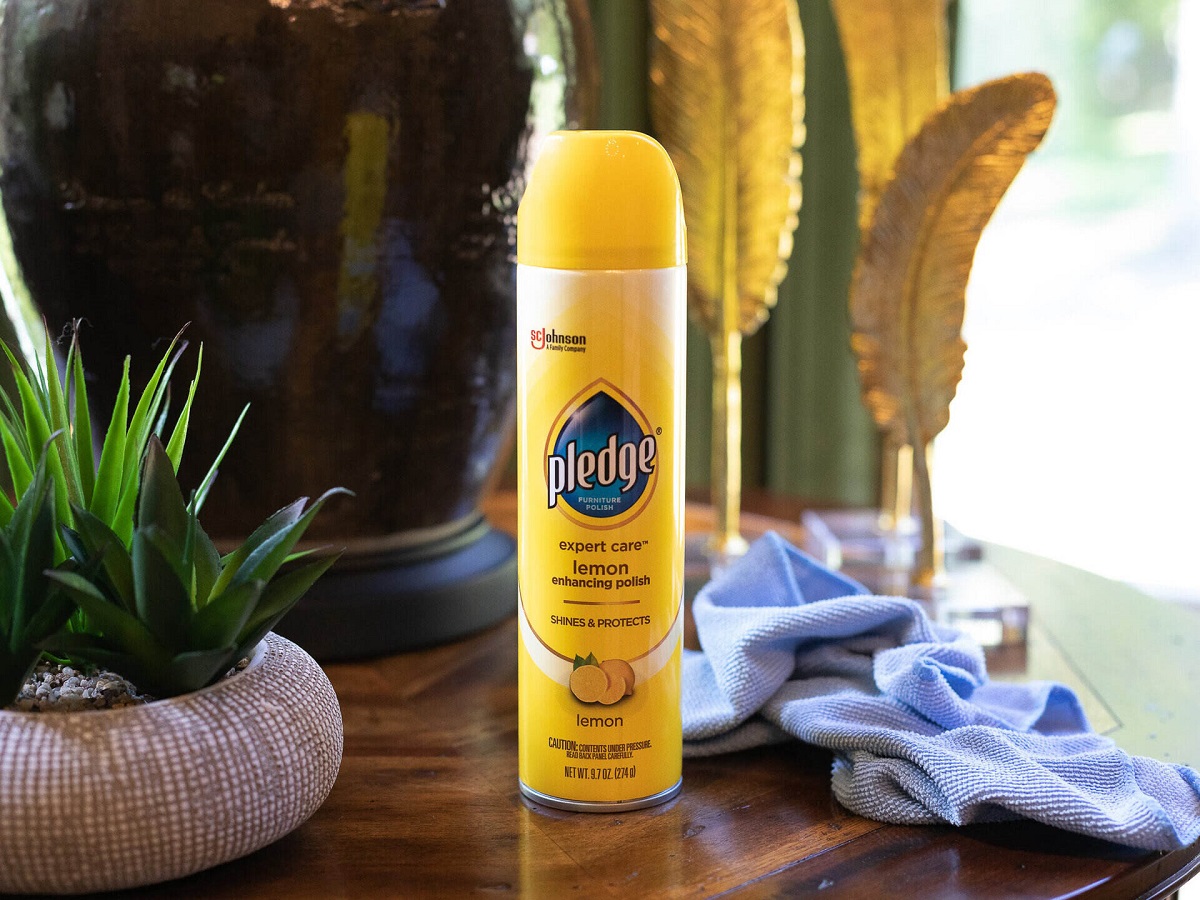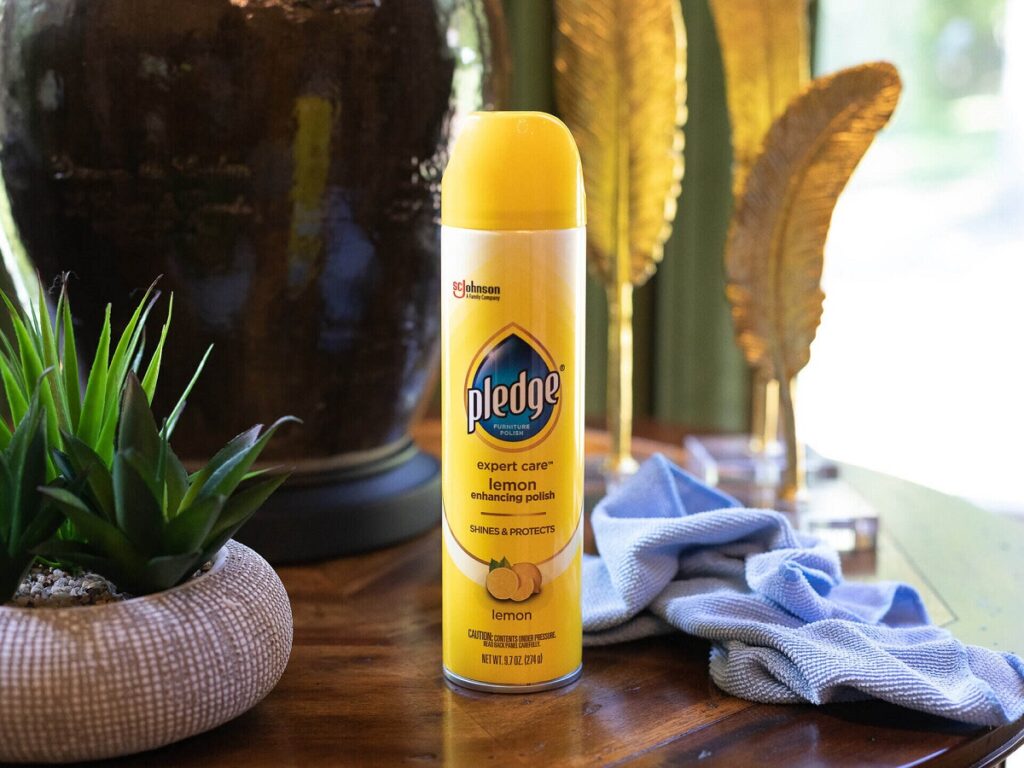
Amish furniture, known for its craftsmanship and durability, holds a special place in many homes. Yet, when it comes to maintaining its beauty, there’s a common dilemma: is it safe to use Pledge on these wooden treasures?
Using Pledge on Amish furniture can lead to silicone buildup, affecting the wood’s natural finish and beauty. Alternatives like natural beeswax or oil-based polishes are recommended to preserve the wood’s integrity, embracing gentle maintenance over aggressive cleaning.
Discover the nuances of caring for Amish furniture and whether products like Pledge suit these handcrafted pieces as we delve into the best practices for their preservation and upkeep.
The Impact of Pledge on Wood Furniture
When considering the use of Pledge on wood furniture, it’s essential to understand the potential impacts of its chemical ingredients on the wood.
While Pledge is designed for cleaning and shining, its long-term effects may not align with preserving the natural qualities of wood, especially in handcrafted furniture like Amish pieces.
Below are specific impacts to consider:
- Chemical Build-Up
Pledge contains silicones and waxes that can accumulate on wood surfaces over time. This build-up can form a sticky layer, detracting from the natural look and feel of the wood.
The accumulation dulls the appearance and makes future cleaning more challenging, as it attracts and holds more dust and dirt.
- Moisture Absorption Interference
The silicone in Pledge can create a barrier on the wood surface, impacting the wood’s natural ability to absorb and release moisture. This interference can lead to dryness in the wood, making it more prone to cracking and warping.
The natural balance and breathability of the wood are disrupted, which is essential for its longevity and structural integrity.
- Aesthetic Alteration
Regular use of Pledge might initially enhance the furniture’s shine, but over time, it can lead to an unnatural, overly glossy appearance. This artificial sheen masks the wood’s natural beauty and can make it feel greasy or slippery to the touch.
The true character and grain of the wood are often obscured under this synthetic layer.
- Potential for Refinishing Issues
The residue left by Pledge can pose challenges during refinishing projects. The silicone and wax layer can prevent new stains or finishes from adhering correctly to the wood, leading to uneven or blotchy results.
This can complicate restoration efforts and may require professional intervention for effective removal.
The Debate Around Using Pledge on Wood Furniture

Understanding both sides of this debate helps make an informed decision about using Pledge on wood furniture. It’s not just about the immediate results but also about considering the long-term implications on the cherished pieces in our homes.
Supporters of Pledge argue that its ability to clean and add shine to wood surfaces quickly is unmatched. They point to its convenience and the immediate gratification of seeing furniture look rejuvenated.
For busy individuals or those looking for a quick fix, Pledge seems like an ideal solution. It’s readily available and has been a household name for years, adding to its appeal.
Critics of Pledge, however, point to potential long-term damage caused by its chemical components, particularly silicones and waxes.
These substances can build up over time, attracting more dust and potentially interfering with the wood’s natural moisture absorption. This can lead to dryness, cracking, and other forms of deterioration.
Moreover, a study on “Effects of Wood Treatment with Amino-silicone Emulsions on Different Material Properties” reveals that silicone particles, especially from micro-emulsions, can deeply penetrate the wood’s cell walls.
While this can reduce shrinking and water uptake, it raises concerns about the long-term impact on wood’s natural properties and its ability to ‘breathe,’ challenging the notion of silicone-based products as a benign solution for wood care.
In navigating this debate, many advise a balanced approach. While Pledge can be helpful for certain types of furniture and situations, it’s essential to be aware of the potential downsides.
It’s recommended to use such products sparingly and to regularly assess the condition of the furniture to ensure that it’s not being adversely affected in the long run.
Why Pledge May Not Be Ideal for Amish Furniture
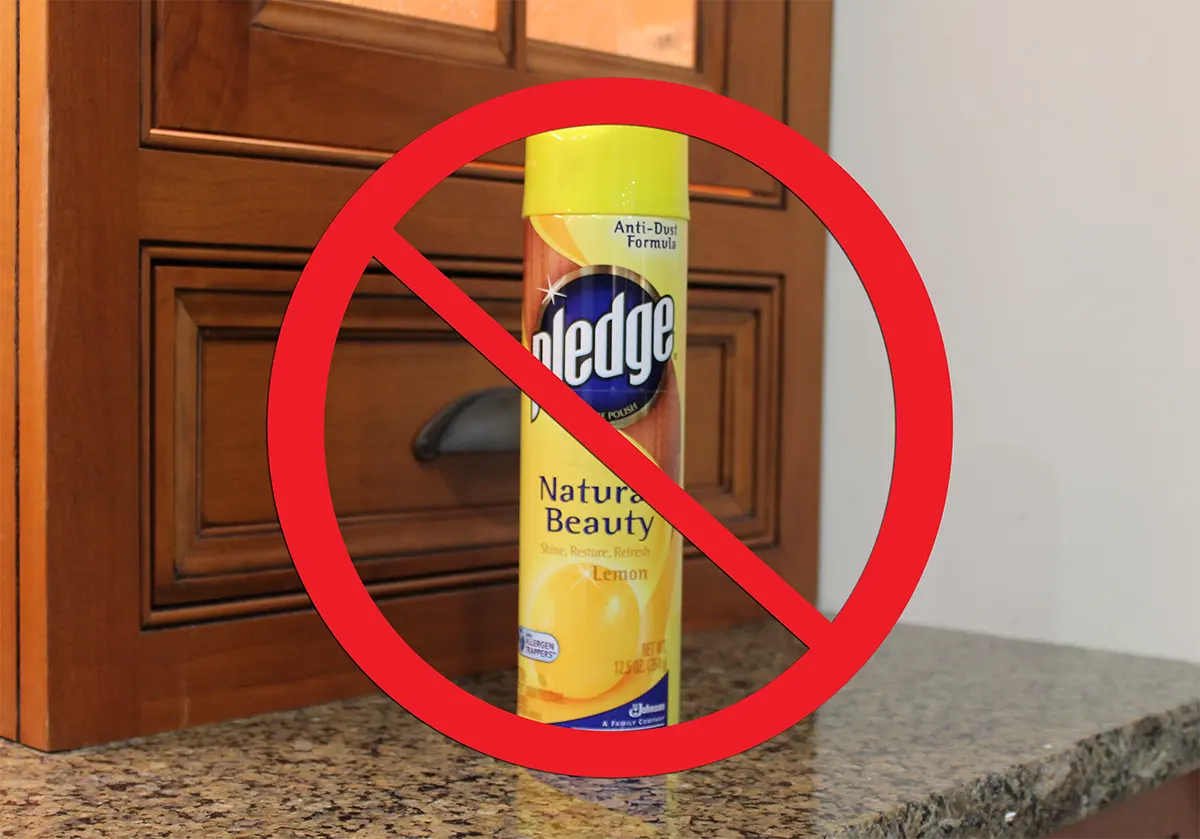
While Pledge is a popular choice for many types of wood furniture, its chemical composition may not be compatible with the unique needs of Amish furniture.
Unique Characteristics of Amish Furniture
Amish Furniture is renowned for its handcrafted quality and use of natural wood. This type of furniture often features a finish that enhances the wood’s natural grain and color.
Pledge, which contains silicone and other synthetic chemicals, can interfere with this natural finish. Over time, the silicone can form a layer that detracts from the wood’s natural beauty and may even harm the finish.
Long-Term Impact of Chemicals from Pledge
Unlike mass-produced items, Amish furniture is often made with traditional techniques and natural finishes that are more susceptible to chemical alterations over time.
- Alteration in Furniture Appearance
Pledge’s chemical composition can alter the natural aging process of wood. Amish furniture is known for developing a rich patina over time, which can be disrupted by the regular use of silicone-based polishes.
These polishes can create a barrier that hinders the wood’s natural oxidization, leading to less authentic aging and maturing of the furniture’s appearance.
- Compromised Repair and Restoration
In the long run, the residues from products like Pledge can complicate repair and restoration woodwork on Amish furniture. The silicones and waxes may react adversely with traditional stains and finishes used in restoration processes.
This can result in uneven absorption of the products, making it challenging to achieve a uniform finish or to match the original color and texture during repairs.
- Impact on Wood’s Natural Scent
Amish furniture, especially made from certain types of wood like cedar or pine, is often appreciated for its natural scent, which contributes to its allure and ambiance. The chemicals in Pledge can mask or alter these natural scents, diminishing one of the sensory experiences of owning authentic Amish furniture.
- Environmental Considerations
Finally, the environmental aspect of long-term chemical use on furniture is worth considering. Frequent use of chemical-based products like Pledge contributes to indoor air pollution and can affect the overall air quality in your home.
This is particularly important in homes with Amish furniture, as the ethos of Amish craftsmanship often aligns with natural, environmentally conscious living
Preserving the Authenticity
For those who value the authenticity and longevity of their Amish furniture, using Pledge may not align with these priorities. The appeal of Amish furniture lies in its natural beauty and traditional craftsmanship, which can be best maintained by using products recommended explicitly for such furniture.
This often means avoiding silicone-based polishes like Pledge and opting for more natural, gentle cleaning methods.
How to Remove Pledge Residue from Furniture
If you’ve used Pledge on your furniture and are now facing a sticky residue, don’t worry. There are effective ways to remove this buildup and restore the furniture’s natural beauty.
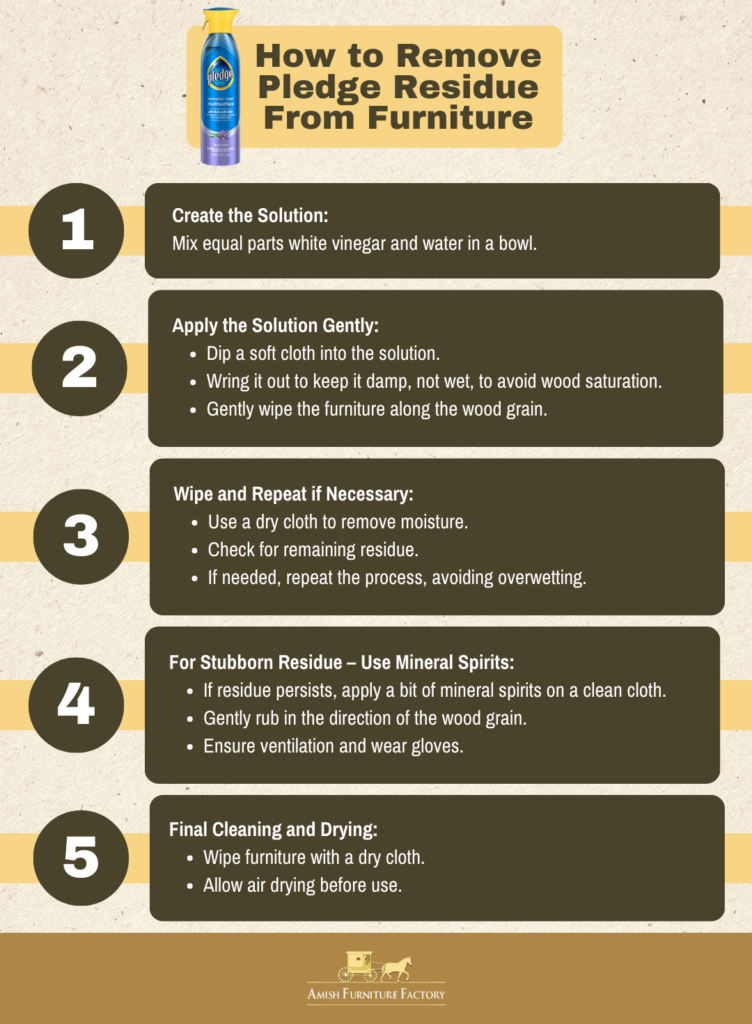
Initial Cleaning with Vinegar and Water
A simple yet effective way to start is using white vinegar and water. Mix equal parts of each and lightly dampen a soft cloth with the solution.
Gently wipe the furniture’s surface, going with the grain of the wood. This method helps to dissolve and lift the silicone-based residue without damaging the wood.
Thorough Cleaning for Stubborn Residue
For more stubborn buildup, a deeper cleaning might be necessary. You can use mineral spirits, which are more effective at breaking down heavy residue.
Apply a small amount on a soft cloth and rub it gently on the affected area. Using mineral spirits in a well-ventilated area and wearing gloves to protect your skin is essential.
Final Touches and Drying
After cleaning, wiping the furniture with a dry, soft cloth is crucial to remove any remaining moisture or cleaning solution. This step ensures no residue is left behind and helps prevent any potential water marks or damage to the wood.
Specific Care for Amish Furniture
Caring for Amish furniture is about embracing gentle, regular maintenance rather than aggressive cleaning techniques. Following these guidelines, your Amish furniture can remain a beautiful and durable part of your home for many years.
Regular Dusting and Cleaning
The first step in caring for Amish furniture is regular dusting. Use a dry cloth to wipe away dust from the surface gently. A slightly damp cloth can be used for cleaning, but avoid using excessive water.
Always dry the surface immediately after cleaning to prevent water marks.
Avoiding Harsh Chemicals
It’s important to avoid harsh chemical cleaners and polishes on Amish furniture, such as those containing silicone or ammonia. These chemicals can damage the natural finish of the wood.
Instead, use gentle, natural cleaning products designed to protect wood furniture. This approach helps preserve the wood’s integrity and appearance.
Dealing with Spills and Stains
In case of spills, act quickly to blot them up with a soft, absorbent cloth. Avoid rubbing the spill, which can push it deeper into the wood.
For tougher stains, consult a professional or refer to the manufacturer’s guidelines. It’s crucial to treat stains appropriately to avoid damaging the wood.
Alternatives to Pledge for Amish Furniture Care
By choosing the following alternatives, you can ensure that your Amish furniture receives the gentle, respectful treatment it deserves, maintaining its beauty and integrity for years.
Remember, the key to caring for Amish furniture is simplicity and using products that complement its natural qualities.
Natural Beeswax Polish
One of the most recommended alternatives is natural beeswax polish. Beeswax provides a protective coating that nourishes the wood without the harmful effects of chemicals found in conventional polishes.
It enhances the wood’s natural grain and leaves a soft, lustrous finish. When applying, use a soft cloth and rub in the direction of the grain, then buff to a shine.
Oil-Based Polishes
Another option is oil-based polishes, particularly those made with natural oils like lemon or orange. These oils condition the wood, replenishing its natural moisture and preventing it from drying.
They also offer a pleasant, natural fragrance. Apply sparingly with a soft cloth and buff gently.
Homemade Cleaning Solutions
Vinegar mixed with olive oil can be an effective cleaner and polish for those who prefer DIY solutions. Mix equal parts of vinegar and olive oil, apply it to the furniture with a clean cloth, and then buff it dry.
This mixture cleans the surface and leaves a subtle, natural sheen.
You also might want to explore these gentle and effective alternatives to Pledge below, specifically tailored for the unique care of Amish furniture.
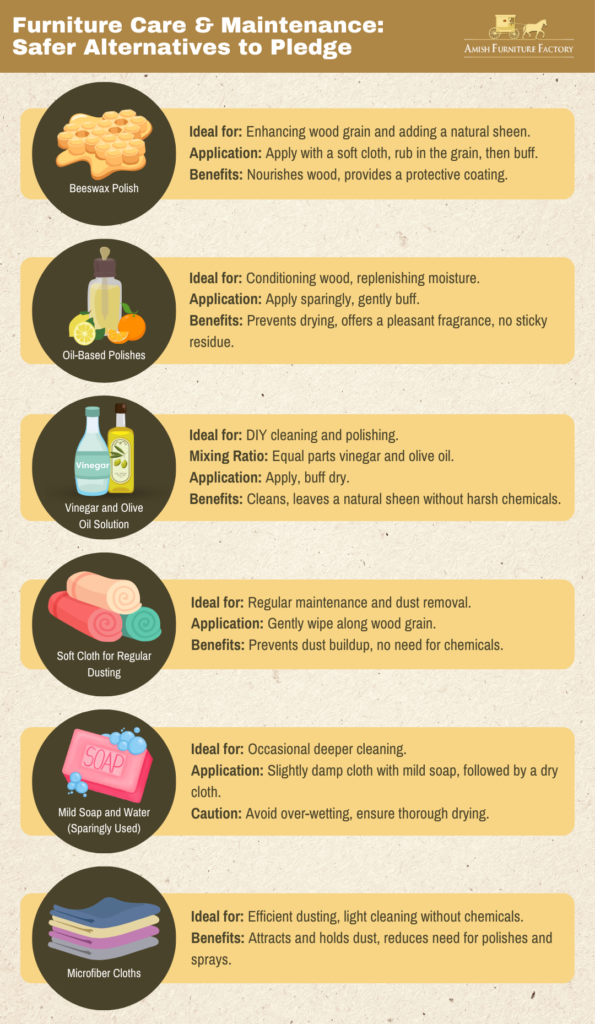
Preserving the Essence of Amish Furniture
Considering the potential long-term effects of chemical polishes like Pledge, it becomes clear that gentler, more natural methods are preferable for Amish Furniture.
By choosing the right care products and methods, we can maintain the physical appearance of our furniture and respect the artistry and heritage it represents. In Amish furniture care, less is often more, and the beauty lies in simplicity and authenticity.
